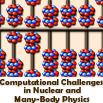Speakers
Andrea Idini
Toshio Suzuki
Description
T. Suzuki
Nuclear shell structure, nuclear forces and nuclear weak
processes
Shell-model study of spin modes in nuclei have been done
with new shell-model Hamiltonians which have proper tensor
components, and applied to nuclear weak processes at stellar
environments. Roles of nuclear forces, especially the tensor
and three-body interactions, on nuclear structure and shell
evolutions are investigated. New shell-model Hamiltonians
for p-shell (SFO [1]) and pf-shell (GXPF1[2]) and VMU
(monopole-based universal interaction) [3], are found to
describe spin-dependent modes in nuclei very well such as
Gamow-Teller (GT) strength in 12C [1], 40Ar [4], 56Fe and
56Ni [5] and magnetic moments of p-shell nuclei [1,6], as
well as shell evolutions toward drip-lines [3,7]. We discuss
some of the following topics on nuclear weak processes at
stellar environments with the use of the new transition
strengths:
(1) New neutrino-nucleus reaction cross sections on light
nuclei are used to study light-element nucleosynthesis in
supernova explosions [8], and the production yield ratio for
11B/7LI is pointed out to be useful to determine the
neutrino-mass hierarchy [9].
(2) New neutrino-induced cross sections are obtained for 13C
[10] and 40Ar [4], which are useful targets for detection of
solar and supernova neutrinos.
(3) New electron-capture rates in Ni isotopes [11] are
obtained with GXPF1 and implications on element synthesis
are studied.
(4) E-capture and beta-decay rates in sd-shell are used to
study nuclear URCA processes in O-Ne-Mg core stars [12].
Roles of the three-body forces, especially the
Fujita-Miyazawa force, on proper shell evolutions of
neutron-rich isotopes [13], as well as on the closed-shell
nature of 48Ca and M1 transition in 48Ca are also studied on
top of the two-body G-matrix obtained by including
core-polarization effects in larger spaces.
1. T. Suzuki, R. Fujimoto and T. Otsuka, Phys. Rev. C 67,
044302 (2003).
2. M. Honma et al., Phys. Rev. C 65, 061301(R) (2002); 69,
034335 (2004).
3. T. Otsuka, T. Suzuki, H. Honma, Y. Utsuno, N. Tsunoda, K.
Tsukiyama and M. Hjorth-Jensen, Phys. Rev. Lett. 104, 012501
(2010).
4. T. Suzuki and M. Honma, Phys. Rev. C 87, 014607 (2013).
5. T. Suzuki et al., Phys. Rev. C 79, 061603 (2009).
6. C. Yuan, T. Suzuki, T. Otsuka, F. Xu and N. Tsunoda,
Phys. Rev. C 85, 064324 (2012).
7. T. Otsuka, T. Suzuki, R. Fujimoto, H. Grawe, and Y.
Akaishi, Phys. Rev. Lett. 95, 232502 (2005).
8. T. Suzuki et al., Phys. Rev. C 74, 034307 (2006).
9. T. Suzuki and T. Kajino, J. Phys. G: Nucl. Part. Phys.
40, 083101 (2013).
10. T. Suzuki, A. B. Balantekin and T. Kajino, Phys. Rev. C
86, 015502 (2012).
11. T. Suzuki, M. Honma, H. Mao, T. Otsuka and T. Kajino,
Phys. Rev. C 83, 044619 (2011).
12. H. Toki, T. Suzuk, K. Nomoto, S. Jones and R. Hirschi,
Phys. Rev. C 88, 015806 (2013); S. Jones et al., Astrophys.
J. 772, 150 (2913).
13. T. Otsuka, T. Suzuki, J. D. Holt, A. Schwenk, and Y.
Akaishi, Phys. Rev. Lett.105, 032501 (2010); J. D. Holt, T.
Otsuka, A. Schwenk and T. Suzuki, J. Phys. G 39, 085111 (2012).
---------------------------------------------------------------------
A. Idini
Nuclear Field Theory, Shell Model, Nuclear Reactions and
Nuclear Astrophysics
Mean field, independent particles, picture is the starting
point of our understanding of the nuclear many-body system.
Many development across those lines in terms of treatment
and effecting interaction, culminating in the last EDF
efforts, enable us to study globally, across the whole
nuclear chart, the bulk properties of nuclei. However
including more complex nuclear correlations, is customary to
exploit the
richness of nuclear structure in the related fields of
nuclear reactions and astrophysics shedding light on
specific, important cases and open problems like the origin
of pairing in nuclei or the importance of forbidden decays
in astrophysical processes. This can be achieved in terms of
including correlation starting from a mean field, and then
considering the interweaving of collective and single
particle degrees of freedom (Nuclear Field Theory), which
gives a reasonable estimate over several type of nuclear
structure observables, remarking the dual origin of nuclear
pairing
and enabling a quantitative account of direct nuclear
reaction's absolute cross sections.
From another point of view, considering the contributions of
the possible configurations, effectively interacting in a
defined valence space (Shell Model), gives a precise
estimate of ground and low-lying states. This is of outmost
importance in
order to estimate quantities related to beta decay and
electron capture, key in several astrophysical process, thus
providing important insight to nuclear astrophysics.
* A. Idini et al., Dual Origin of Pairing in Nuclei,
http://arxiv.org/abs/1404.7365
* G. Potel et al., Cooper pair transfer in nuclei, RPP 76,
106301.
http://iopscience.iop.org/0034-4885/76/10/106301
* A. Idini et al., Quasiparticle renormalization and pairing
correlations in spherical superfluid nuclei, PRC 85, 014331.
http://journals.aps.org/prc/abstract/10.110 /PhysRevC.85.014331

